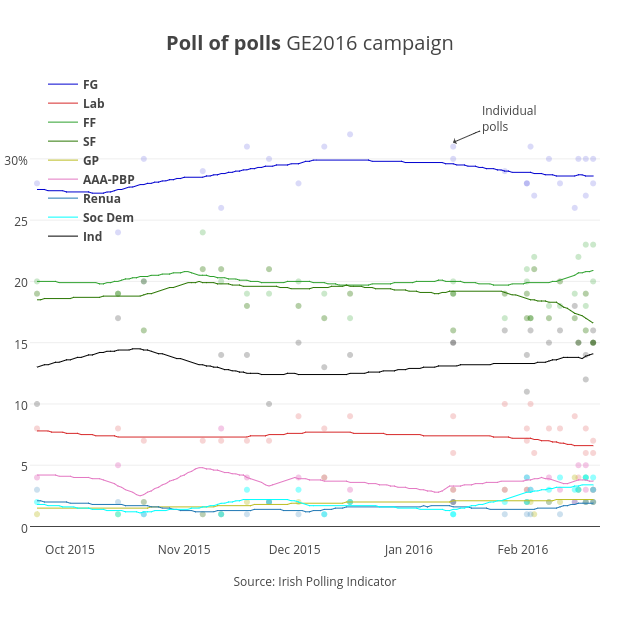The Irish Polling Indicator, which combines all opinion polls in one estimate of public opinion, gives Fine Gael a 28.6 per cent share of the vote and the Labour Party 6.6 per cent.
Both parties need a significant improvement on these figures if the Coalition is to have a realistic chance of retaining power in Friday’s general election.
The polling indicator compiled by political scientist Tom Louwerse suggests there has been a significant shift in support for some of the parties over the past few months.
The poll of polls shows Fine Gael was trending upward in the latter part of 2015 but its momentum stalled since the election was called.
Labour, which was already at a low ebb, has suffered a further marginal decline since the election campaign began.
By contrast, the figures point to a modestly positive trend for Fianna Fáil over the last weeks, with the party now on almost 21 per cent, moving ahead of Sinn Féin to become the second largest party in the polls as election day nears.
Sinn Féin, on the other hand, has seen a significant decline in support: from 19 per cent in January to under 17 per cent now. Over the past five years, the party was usually ahead of Fianna Fáil in the polls although the local elections of 2014 saw Sinn Féin trailing 10 points behind.
During 2015, Sinn Féin was even competing with Fine Gael for first place in the polls, but that standing is now far out of reach.
Compared with its showing of almost 10 per cent in the 2011 general election, 17 per cent still represents a massive increase in support for Sinn Féin but, as in previous elections, the party seems to lose some support during the final weeks of campaigning.
The outstanding feature of the polls is probably the performance of Independent candidates and smaller parties.
The group of Independents and others has improved their total score from about 22 per cent early this year to 25 per cent in the Indicator.
Within that group, the Social Democrats are performing strongly and are currently polling well over 3 per cent, with AAA-PBP on almost 4 per cent and Renua on 2 per cent. Independent candidates, including the Independent Alliance, are now on more than 14 per cent support.
It is important to note that some people are still in the process of making up their minds. In the final Irish Times/Ipsos MRBI poll, 18 per cent of people were still undecided while some other polls have a lower figure of 10 per cent still undecided.
Moreover, the gap between Fine Gael and Fianna Fáil is much wider in some polls – 12 per cent with Red C – than in others, with Millward Brown putting it at 4 per cent and Ispsos MRBI recording a 5 per cent gap.
This averages out to about 7.5 per cent in the Indicator, but the large discrepancies between pollsters point to some uncertainty as to exactly how big Fine Gael’s lead over Fianna Fáil is.
Tom Louwerse is assistant professor of Political Science at Leiden University, the Netherlands. He started his work on the Irish Polling Indicator when he held the same position at Trinity College, Dublin, between 2013 and 2015. The Irish Polling Indicator combines all Irish opinion polls for the Dáil into one estimate of public support for the parties. Read more about the poll of polls and methodology.











